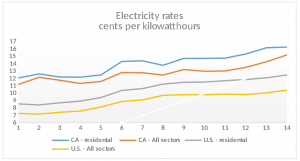Organics: Another Fine Government Mess
The Organic Foods Production Act (OFPA), as part of the 1990 Farm Bill, established the National Organic Program (NOP). The program, as administered by the United States Department of Agriculture (USDA), oversees uniform standards governing the marketing of organically produced products. The NOP’s mission is to assure consumers of consistent organic standards of production and to facilitate the interstate commerce of organically produced food.
At the time of the NOP’s inception, the organic market for farm products had an estimated annual value of $1 billion. By 2012, U.S. certified organic sales were at $28.4 billion and according to the USDA’s Economic Research Service (ERS), the sales for 2014 are estimated at $35 billion. It is clear that organic sales are showing significant growth, but at what costs?
The current Chipotle E. coli outbreak offers an opportunity for shoppers to understand the true nature of the USDA’s organic certification program. Numerous studies and public opinion polls find consumers overwhelmingly believe the higher priced, organically certified food is a healthier, safer choice. However, experts, consumer groups and scientific research does not support that view.
In one example, a 14-page letter dated October 8, 2015, by the Consumer Reports National Research Center details many of the failings of the NOP. The letter criticizes the National Organic Standards Board (NOSB) for approval of synthetic and non-organic nutrient additives and synthetic pesticide material, even in baby formulas. The letter states, “We support the proposal to remove nonylphenol ethoxylates (alkylphenol ethoxylates) or NPEs/APEs from the list of “inerts” allowed in organic production because of their toxic and endocrine-disrupting effects.”
The Consumer Reports letter demonstrates the discrepancy between what the NOP entails and what the public believes the program offers. The NOP outlines the rules and processes to create uniformity for organic labeling. Although there are restrictions and prohibitions of a variety of chemical applications, the program allows for many waivers and exemptions. Nowhere in the program does it suggest certification assures a safer or more nutritious food choice. In fact, Dr. Stuart Smyth, a food safety expert and agriculture biotechnology researcher calls the National Organic Standards, “an illusion of food safety.” As Smyth explains, “These organic standards pertain to seed, fertilizer, and chemicals that are allowed to be used to produce a crop that will be certifiably organic when it is ready to be harvested. These production standards have absolutely nothing to do with increasing food safety.”
Still, the organic industry, as a marketing ploy, perpetuates the myth to consumers that organic certification implies safer foods. Moreover, with the ever-growing market share, one would assume conscientious shoppers increasingly prefer organic foods. Do they or is that another false assumption? What has changed in the past 15 years to drive the annual market value of organic food products from $1 billion to $35 billion if not consumer preference? How about the huge increase in consumer prices for the organic products, the increased volume of the labeled products, and the massive increase in program funding? To explain, let’s consider just some of the taxpayer dollars pumped into the NOP by means of the most recent farm bill, the 2014 Farm Act.
- $20,000,000 for each fiscal year 2014 through 2018 for program operation
- $5,000,000 to the Secretary of Agriculture for data collection and distribution to National Agriculture Statistics Service (NASS) and Agricultural Marketing Service (AMS).
- $15,000,000 for each fiscal year 2014 through 2018 for modernization and technology upgrade
- $5,000,000 upgrade collaboration with Commodity Credit Corporation (CCC).
- $11,500,000 for each fiscal year 2014 through 2018 for cost-share programs with CCC.
- $7,000,000 for each of the fiscal years 2014 through 2018 for natural products research.
In the above designated funding commitments alone, the federal government will spend $277.5 million through the term of the current agriculture authorization bill. An astonishing amount, considering the original 1990 Organic Foods Production Act stipulated the program costs will be covered entirely by fees gleaned from the program’s participants.
The growth of the organic market follows the growth in federal dollars pumped into the program. Food safety is not improved. Consumers have no assurance they are purchasing a more nutritious product. Third party certifiers charge upwards of $3,000 to farmers for label use creating an incentive for fraud. Foreign products are certified outside of the U.S. by foreign agents with no USDA oversite. Contemporary farmers are at a competitive disadvantage as a result of the marketing, promotion, and price difference of organically labeled product. Organic foods can potentially be less safe than their uncertified counterpart. And, in the end, the taxpayers are again burdened with an unproductive, fraud-laden, market manipulating program that offers no demonstrative benefit.
